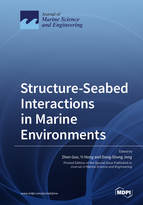Structure-Seabed Interactions in Marine Environments
A special issue of Journal of Marine Science and Engineering (ISSN 2077-1312). This special issue belongs to the section "Ocean Engineering".
Deadline for manuscript submissions: closed (15 April 2021) | Viewed by 23955
Special Issue Editors
Interests: offshore geotechnics; ocean engineering; coastal groundwater hydraulics; offshore wind energy
Special Issues, Collections and Topics in MDPI journals
Interests: wave-seabed-structure interaction; offshore foundation; submarine pipeline; mooring system
Special Issues, Collections and Topics in MDPI journals
Interests: offshore geotechnics; soil constitutive model; underground space technology in coastal region
Special Issue Information
Dear Colleagues,
The safety and resilience of offshore development, including exploration of fossil and renewable energy and construction of offshore transportation (e.g., submarine tunnel, and cross-sea bridge), primarily depend on the stability and deformability of the offshore structure. This is critically governed by the complicated interactions between the fluid, offshore structures, and the seabed, which usually exhibit low strength and stiffness under cyclic loadings. Offshore structures include but are not limited to a fixed platform, offshore wind turbine foundations, underwater tunnels, cross-sea bridges, floating facility, and submarine pipelines. Meanwhile, the soil conditions of the seabed are often unusual, particularly in respect of carbonate soils, gassy soils, and structured sensitive soils.
Problem: In marine environments, various offshore structures, foundations, and subsea facilities are often subjected to extreme environmental loadings during hurricanes or typhoons. On the other hand, the weak seabed may not be able to offer sufficient resistance to these extreme loadings. The coupling of the above two issues that results in a failure in fluid–soil–structure interaction (FSSI) is proven to be the main cause for the catastrophes of offshore infrastructures which have occurred in past decades. This has necessitated a fundamental understanding of FSSI, and scientific/design methods for quantifying FSSI, with full considerations of loading characteristics and constitutive behavior of marine sediments.
Current practice: While the great majority of geotechnical engineers still rely on empirical and decoupled models to predict the deformation and stability of offshore structures, there is an increasing trend to develop macro element models by imposing springs at the soil–structure interface. Constitute soil models with an increasing level of complications have been emerging as a subroutine for finite element analysis, which enables modeling of fully coupled offshore structure–seabed interactions. With these great advancements in SSI based on different principles, there is a need to revisit and better identify the key aspects to be considered for offshore structure–soil interaction.
Goal: The scope of this Special Issue is to gather original fundamental and applied research concerning experimental, theoretical, computational, and case studies that contribute toward an understanding and improvement of offshore structure–soil interaction. The topics include but are not limited to SSI associated with problems of:
- Marine sediment characterization;
- Offshore oil and gas production;
- Offshore renewable energy infrastructures;
- Port and coastal disaster prevention;
- Submarine/cross-sea transportation.
Prof. Dr. Dong-Sheng Jeng
Prof. Dr. Zhen Guo
Prof. Dr. Yi Hong
Guest Editors
Manuscript Submission Information
Manuscripts should be submitted online at www.mdpi.com by registering and logging in to this website. Once you are registered, click here to go to the submission form. Manuscripts can be submitted until the deadline. All submissions that pass pre-check are peer-reviewed. Accepted papers will be published continuously in the journal (as soon as accepted) and will be listed together on the special issue website. Research articles, review articles as well as short communications are invited. For planned papers, a title and short abstract (about 100 words) can be sent to the Editorial Office for announcement on this website.
Submitted manuscripts should not have been published previously, nor be under consideration for publication elsewhere (except conference proceedings papers). All manuscripts are thoroughly refereed through a single-blind peer-review process. A guide for authors and other relevant information for submission of manuscripts is available on the Instructions for Authors page. Journal of Marine Science and Engineering is an international peer-reviewed open access monthly journal published by MDPI.
Please visit the Instructions for Authors page before submitting a manuscript. The Article Processing Charge (APC) for publication in this open access journal is 2600 CHF (Swiss Francs). Submitted papers should be well formatted and use good English. Authors may use MDPI's English editing service prior to publication or during author revisions.
Keywords
- Marine sediment characterization
- Offshore oil and gas production
- Offshore renewable energy infrastructures
- Port and coastal disaster prevention
- Submarine/cross-sea transportation








